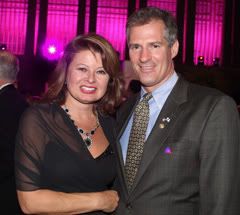You’ve heard about Senator Scott Brown from Massachusetts by now. He’s the Republican (yes, you read that correctly) who made international headlines by winning Senator Ted Kennedy’s Senate seat (not a Republican) in the bluest state in the country and upsetting the Democratic majority in the U.S. Senate…no mean feat.
How did he do it? It’s all about the brand.
Starting your brand
 Building your brand is different than building your career. Sure, Brown had been doing his job prior to election for a respectable time, but very few people had ever heard of him. You can do your job year after year with your green eyeshades on and your head down, but no one – outside of the person in the cubicle next to you – will notice. How do you start changing that milk toast image into a profile that people will respect and follow?
Building your brand is different than building your career. Sure, Brown had been doing his job prior to election for a respectable time, but very few people had ever heard of him. You can do your job year after year with your green eyeshades on and your head down, but no one – outside of the person in the cubicle next to you – will notice. How do you start changing that milk toast image into a profile that people will respect and follow?
You can start today. You make a decision. “Now is the time. How do I want to be known? What’s one, manageable thing that I can start doing today that distinguishes me from the rest?” With Scott, he agreed to run against a well known Democrat, Martha Coakley, when even his own party didn’t expect him to win. You can start on a grand scale, or just step forward to write a blog, or lead a project at work.
Big picture first
Scott (and probably his campaign committee) set strategy first. “Let’s develop my brand to be warmth, openness, of-the-people, leadership, and cuteness,” he’s bound to have said. (Okay, I’m stretching on the cuteness part, but he is.) He undoubtedly had a political platform, too, but this isn’t about that. After all, do you always vote for people because of their political stands, or sometimes, just sometimes, because “they’re someone you’d rather have a beer with?
Your brand goals are made real by actions. How do the rest of us get what you’re communicating otherwise? What you say, do, and message nonverbally, as well as verbally to build your brand continually and ideally, are consistent with the reputation and values that you want as a professional and as a person. Let’s stay superficial with the nonverbal, observable part now.
Do clothes make the man?
Senator Brown sends clarion non-verbal messages that support his non-fancy, populist image through channels that you can use as well:
Clothing
Tangible symbols (houses, cars, activities, etc.)
Physical impression (hair, body art, weight, etc.)
Body language, i.e. how you carry yourself
We’ll touch on the first two today, but keep the last two in your plans. With clothes, Scott started barnstorming the state as a candidate in his barn jacket, a visible image of his “common man” brand that he became known for. He must have liked the results because he was at a fancy party at the Museum of Fine Arts in Boston last week in his nice-but-not-fancy plaid suit (see photo).
Everyone, every other man in a group of 800, was in black tie. His wife, Gail Huff, a news reporter for WCVB-TV in Boston, wore a beautiful ball gown with striking jewelry. Can you imagine the conversation they had as they were dressing for the event that evening? He chose his brand and he’s sticking to it.
Cars and consistency
Other tangible symbols beyond clothing range from houses to leisure activities to cars. Scott’s GMC pickup added to his populist image, big time. He leveraged the truck’s image frequently by sitting in it for a taping of Saturday Night Live and referencing it in multiple campaign speeches.
Being conscious of the many ways you communicate with others before you open your mouth is a level of self-awareness that pays off in brand and career management. Saying that you’re fast and turn around projects on a dime is a disconnect if you’re not athletic-looking and evoking energy (unless you’re Shaq). Saying that you want to advise high net worth families about their investments when you’ve recently graduated from college is a disconnect. Consistency between nonverbal and verbal is the key.
Other people’s brains
I’m not talking about what’s fair or correct. I’m talking about anticipating the unconscious judgments that we make all of the time, then using these beliefs to your advantage. Whether it’s barn jackets, pickup trucks, Victory Gardens, or well-tailored business suits, what nonverbal symbols are you using to communicate your brand and are they consistent with your goals? You may be our next senator.
Author:
Pam Lassiter is author of the award winning The New Job Security and Principal of Lassiter Consulting, a career coaching firm doing outplacement or internal growth programs for companies or individuals.












